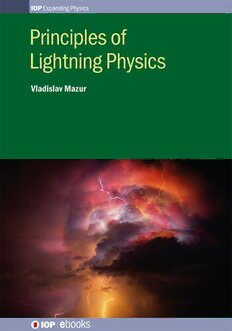
Principles of Lightning Physics PDF
Preview Principles of Lightning Physics
Principles of Lightning Physics Principles of Lightning Physics Vladislav Mazur National Severe Storms Laboratory, Norman, Oklahoma, USA IOP Publishing, Bristol, UK ªIOPPublishingLtd2016 Allrightsreserved.Nopartofthispublicationmaybereproduced,storedinaretrievalsystem ortransmittedinanyformorbyanymeans,electronic,mechanical,photocopying,recording orotherwise,withoutthepriorpermissionofthepublisher,orasexpresslypermittedbylawor undertermsagreedwiththeappropriaterightsorganization.Multiplecopyingispermittedin accordancewiththetermsoflicencesissuedbytheCopyrightLicensingAgency,theCopyright ClearanceCentreandotherreproductionrightsorganisations. PermissiontomakeuseofIOPPublishingcontentotherthanassetoutabovemaybesought [email protected]. VladislavMazurhasassertedhisrighttobeidentifiedastheauthorofthisworkinaccordance withsections77and78oftheCopyright,DesignsandPatentsAct1988. Videocontentisavailablefromthebookinformationonline:https://doi.org/10.1088/978-0-7503- 1152-6. ISBN 978-0-7503-1152-6(ebook) ISBN 978-0-7503-1153-3(print) ISBN 978-0-7503-1154-0(mobi) DOI 10.1088/978-0-7503-1152-6 Version:20161201 IOPExpandingPhysics ISSN2053-2563(online) ISSN2054-7315(print) BritishLibraryCataloguing-in-PublicationData:Acataloguerecordforthisbookisavailable fromtheBritishLibrary. PublishedbyIOPPublishing,whollyownedbyTheInstituteofPhysics,London IOPPublishing,TempleCircus,TempleWay,Bristol,BS16HG,UK USOffice:IOPPublishing,Inc.,190NorthIndependenceMallWest,Suite601,Philadelphia, PA19106,USA Coverimage:SummerlightningstormnearTucson,Arizona,USA.Credit:KeithKent/Science PhotoLibrary To Marijo, my beloved wife, without whose encouragement and support this book would not have been possible Contents Preface xi Acknowledgements xiv Author biography xv 1 The components of lightning 1-1 1.1 Features of lightning plasma 1-1 1.2 Lightning is more than a spark 1-2 1.2.1 Corona glow 1-2 1.2.2 Corona streamers 1-3 1.2.3 Transition from corona streamers to a positive leader 1-5 1.2.4 Transition from corona streamers to a negative leader 1-6 1.3 Conditions for leader propagation 1-8 1.4 Lightning leaders in nature 1-12 References 1-15 2 Lightning leaders versus free-burning arcs 2-1 2.1 Similarities and differences 2-1 2.2 The E–I relationship, from the results of laboratory measurements and 2-2 the modeling of free-burning arcs 2.3 The E–I relationship and the luminosity of leader channels 2-7 References 2-9 3 Physical concepts of a lightning leader model 3-1 3.1 The space charge leader concept based on cloud charge collection 3-1 3.2 The bi-directional, uncharged leader concept based on induced charges 3-3 3.3 Comparing the outputs of the two leader models 3-5 References 3-8 4 Verifying the concept of the bidirectional leader 4-1 4.1 How studying lightning strikes to aircraft has helped to solve 4-1 the puzzle of lightning development 4.1.1 Lightning radar echo 4-2 4.2 How does an aircraft trigger lightning? 4-5 vii PrinciplesofLightningPhysics 4.3 Environmental conditions that lead to aircraft-triggered lightning 4-9 4.3.1 Hypothesis of a natural lightning-triggering mechanism in 4-11 thunderstorms References 4-13 5 Defining the types of lightning 5-1 5.1 The visible features of lightning flashes 5-1 5.2 Defining the types of lightning using the bidirectional, bipolar 5-7 leader concept 5.2.1 Intra-cloud flashes 5-7 5.2.2 Cloud-to-ground flashes 5-11 References 5-14 6 The electrostatic theory of lightning discharges 6-1 6.1 Cloud potential and induced charges of lightning 6-1 6.2 The relationship between the electric fields produced by leaders 6-2 and return strokes 6.3 The relationship between lightning processes and space charges in 6-4 thunderstorms 6.3.1 Thunderstorm model 6-4 6.3.2 Development of the cloud-to-ground leader 6-6 6.3.3 Return stroke 6-11 6.3.4 Electric field changes produced by CG flashes 6-12 6.3.5 Development of the intra-cloud leader 6-13 6.4 Applications and limitations of the electrostatic model 6-14 References 6-17 7 Lightning triggered by rockets with wire and by tall structures 7-1 7.1 The idea of artificially triggered lightning 7-1 7.2 Concept and features of the classic rocket-triggered lightning technique 7-2 7.2.1 Processes related to melting of the trailing wire 7-3 7.3 Concept and features of the altitude-triggered lightning technique 7-6 7.4 Conditions required for triggering lightning with rocket-and-wire 7-7 techniques 7.5 On leaders and return strokes in rocket-triggered lightning 7-8 7.6 Upward lightning triggered by tall ground structures 7-9 7.6.1 Conditions for upward lightning initiation 7-9 viii PrinciplesofLightningPhysics 7.6.2 Understanding luminosity variations in the upward-lightning 7-12 channel 7.7 Features of positive and negative leaders determined from studies of 7-15 triggered lightning References 7-18 8 Understanding current cutoff in lightning 8-1 8.1 Definition and manifestation of current cutoff in different 8-1 lightning events 8.2 The death of the leader in unbranched lightning channels 8-2 8.3 Current cutoff in branched leaders 8-3 8.3.1 The screening effect in single and branched channels 8-3 8.3.2 The role of branch-screening in current cutoff 8-4 8.4 Arc instability and current cutoff 8-8 References 8-9 9 The phenomenon of recoil leaders 9-1 9.1 The nature of recoil and dart leaders 9-1 9.2 The relationship between recoil leaders and M-events: cause 9-5 and effect 9.3 The electrostatic model of an M-event that produces an 9-9 M-component 9.3.1 The electrostatic model of a dart leader–return stroke 9-10 sequence in CG flashes 9.3.2 The electrostatic model of an M-event 9-12 9.4 The universal nature of M-events in lightning 9-14 References 9-15 10 The physical concept of recoil leader formation 10-1 10.1 The relationship between the internal electric field and current in 10-1 lightning leaders 10.2 Current cutoff prior to the occurrence of recoil leaders 10-2 10.3 The development of recoil leaders 10-3 10.4 A proposed conceptual model of recoil leader formation 10-5 10.4.1 Recoil leader formation and polarity asymmetry in 10-8 branched leaders 10.5 Conclusion 10-10 References 10-10 ix
